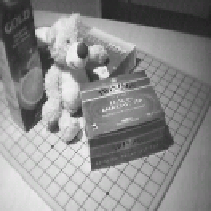Information Technology Reference
In-Depth Information
reported the propagation of the disparity maps of the matched features to their
neighbours.
To la
et al.
reported a new approach based on the local descriptors [28]. This
strategy comes up with a new descriptor that retains the robust features of SIFT and
GLOH. The descriptor is then used for dense matching and view-based synthesis
using stereo-pairs. The kernel of the technique is that computational complexity can
be significantly reduced without sacrificing the performance by convolving orienta-
tion maps to compute the histogram bin values.
A vector here is made of values from the convolved orientation maps located on
concentric circles centered at the pixel location. Let
h
(
u
,
v
) be the vector at (
u
,
v
)
after the convolution by a Gaussian kernel of standard deviation
∑
:
∑
h
∑
(
u
,
v
)=[
G
1
(
u
,
v
)
,...,
G
8
(
u
,
v
)]
T
,
(11)
where
G
1
(
u
,
v
)
,...,
G
8
(
u
,
v
) are the convolved orientation maps. These vectors are
normalised to unit norm
h
so that they represent the pixels near occlusions as correct
as possible. The propsoed descriptor
D
(
u
0
,
v
0
) for location (
u
0
,
v
0
) is then defined as
a concatenated
h
vectors:
D
(
u
0
,
v
0
)=[
h
T
∑
3
(
l
N
(
u
0
,
v
0
,
R
3
))]
T
,
(12)
where
l
j
(
u
,
v
,
R
) is the location with distance
R
from (
u
,
v
)inthe
j
direction that has
N
values. Once these feature have been obtained using the descriptors, similarities
across images will be measured using the graph-cut-based reconstruction algorithm
presented in [32]. An occlusion map is used to handle occlusions using EM and
binary masks that have been redefined to enforce the spatial coherence of the occlu-
sion map. Fig. 11 shows an example where shadows may affect the estimation of the
disparity maps. But in this example, the proposed algorithm handles this situation
well and the shadow area has not been false-positive. In Fig. 12, the proposed al-
gorithm leads details (human statues) to being explicitly separated. Finally, Fig. 13
demonstrates that three images can be combined to improve the outcome generated
using two images.
∑
1
(
u
0
,
v
0
)
,
h
T
∑
1
(
l
1
(
u
0
,
v
0
,
R
1
))
,...,
h
T
∑
1
(
l
N
(
u
0
,
v
0
,
R
1
))
,...,
h
T
Fig. 11
Test triples and the corresponding depth map, where 1st- and 2nd-column are original
images and 3rd-column is the depth map






